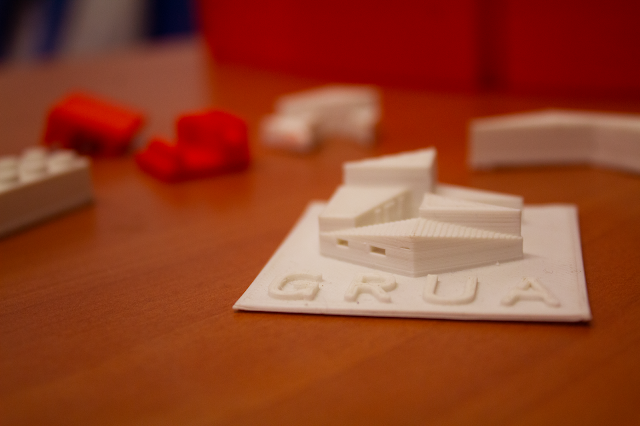Previewing and printing documents is already an everyday occurrence, but now researchers are working to do the same for houses in rural areas — this is being achieved through virtual reality goggles, computer simulations and building-scale 3D printing.
According to Colombian government statistics, in 2019, it was estimated that 36.59% of the Colombian population had a housing deficit: they had no roof over their heads or lived in poor quality housing, especially in rural areas.
To solve the problem in the department of Cauca, in southern Colombia, researchers from the Universidad del Valle (Univalle) are designing modern houses consistent with the worldview and traditions of indigenous communities; and developing technology to give an immersive preview, so those who will live in the house know how their home will look like before it is built.
Professor Armando Orobio Quiñones, Director of the Applied Construction Research Group (GRUA), explained that Building Information Modelling (BIM) was added to the design process, meaning better planning and less hassle in construction.
"You can visualize all the systems such as electrical distribution and plumbing; and with the virtual reality goggles you can feel like you are inside the house," Professor Orobio said.
 |
| Photo: Model representing Grupo GRUA Credit: Adolfo Ceron/NCC-FI/Univalle |
The Research
Prof. Orobio commented that GRUA's research is part of a research project led by Professor Daniel Gómez Pizano, also at Univalle, called “Development Of A 3D Printing System Of Sustainable Non-Conventional Materials For The Advancement Of Rural Infrastructure In The Department Of Cauca.”
The idea is to use 3D printing construction, from local materials such as waste or soil, to build houses in several indigenous communities in the department of Cauca.
"The community would have the opportunity to get involved in the proposed design and make suggestions on the architectural design based on their cultural practices," said Prof. Goméz.
Over four years, starting in 2021, there will be $9.56 billion Colombian pesos (COP) (about $2.5 million) from the General Royalties System of the Cauca department, $3.31 billion COP ($862,000) from the Universidad del Valle (Univalle) and $180 million COP ($47,000) from the Universidad del Cauca (Unicauca).
Professor Sandra Liliana Cano Moya, another GRUA faculty member, commented that virtual reality has the power to generate a communication link between architects and engineers; and also for the people who will live in the house, who will have their own worldview and may not be able to interpret blueprints.
"The construction sector is an industry without prototypes, but with virtual reality, we can immerse people in a prototype," Professor Cano said, adding that this is especially important when working with indigenous communities.
"We want to close the gap between the producer and the consumer," Professor Cano said, adding that the researchers are looking for a more respectful way to approach ancestral knowledge.
Erick Giovanny Ramirez Cardona, a GRUA master's student focused on cost estimation, explained that there are currently no standards, regulations, or best practices that can be referenced to establish construction methods or estimate the costs of a rural housing project with 3D printing.
"If it is identified that any of the scenarios and alternatives are financially and technically viable within the rural context, it would be an option more than worthy of attention by local and national government entities. Therefore, we have to bet on meeting this unsatisfied demand for housing in the Colombian countryside," Ramírez said.
Professor Orobio explained that the idea is to replicate traditional community design elements, while using advanced technology to plan construction and control costs.
"The important thing about 3D printing is to make automated and lower cost constructions," Professor Orobio said.
George Antonny Cadena Guevara, GRUA's master's student explained that there is a need to recreate a virtual environment that presents the information contained in the BIM models. This allows for realistic interaction involving project stakeholders to have feedback and make modifications prior to construction.
"The opportunities of this type of activity is to allow to evidence the conditions of the space and perceive the comfort capabilities for the final client," said Cadena.
In addition, Laura Henao, a GRUA master's student, and Professor Wilmer Campaña, a GRUA researcher, are working on the integration of the BIM model and 3D printing to facilitate the construction of the housing prototype.
|
Read more from Univalle’s school of Civil and Geomatic Engineering: Millions In New Funding Is “One Small Step” For Moon Ideas To Build Houses in Colombia |
 |
| Photo: The 3D printing system for construction. Credit: Adolfo Ceron/NCC-FI/Univalle |
Collaboration with Universidad del Cauca
Professor Jaime Rafael Obando Ante, of the Faculty of Civil Engineering at the Universidad del Cauca explained that the collaboration between the two universities in this project comes through Professors Eimar Sandoval and Armando Orobio of the Universidad del Valle, who are graduates of the Universidad del Cauca.
"It is an excellent opportunity for the end users of the houses to preview the projects, propose changes and adjustments according to the needs, cosmovisions of each interest group," Professor Obando said and added that rural housing in many isolated areas of Colombia, suffer a serious problem associated with the availability of raw materials needed for housing construction; likewise, the high costs of raw materials, transportation costs of inputs have historically generated immense housing deficits.
Si le interesa contactar al investigador o conocer más sobre el proyecto, escriba a la Oficina de Comunicaciones Facultad de Ingeniería: comunicaingenieria(arroba)correounivalle.edu.co
Cover photo: Professor Armando Orobio, director of Grupo de Investigación Aplicada en Construcción (GRUA). Credit: Adolfo Ceron/NCC-FI/Univalle

Comentarios
Publicar un comentario